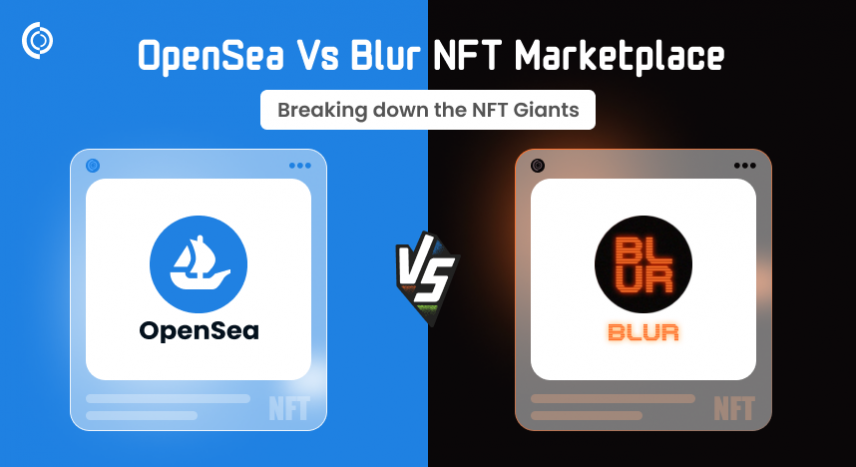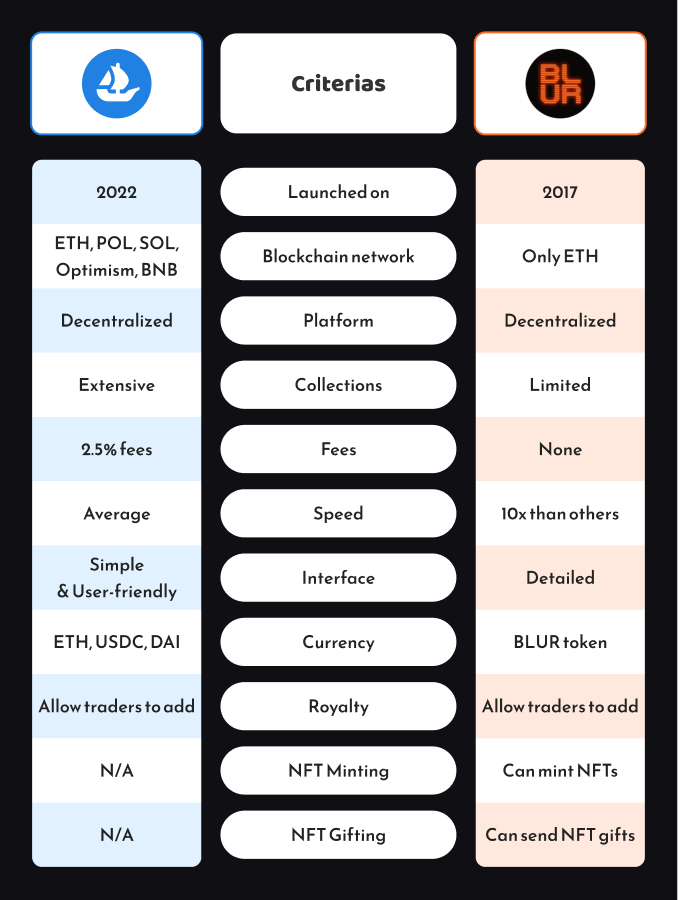The hype for the term ‘NFT’ in the crypto realm has not yet stopped. According to Statista reports, NFT market capitalization is expected to reach $3.2 billion by the year 2027 with an annual CAGR of 18.55%. Can you imagine the growth of NFTs within a few years of introduction? This is because of people’s craze over these NFTs.
Adding fuel to these, many new NFT Marketplaces are emerging into the market and introducing rare NFT collections. As much as rare NFT collections are listed, the NFT Marketplaces gain fame, global outreach, and higher trading volume. But, what is the need for an NFT Marketplace? NFT Marketplaces help users sell, buy, list, or bid their NFTs easily.
By creating this NFT Marketplace, many startups have earned huge profits from various streams. Presently, the NFT Marketplaces that are ruling the crypto space are OpenSea and Blur. OpenSea which was introduced in the year 2017 is the pioneer for all the NFT Marketplaces. Blur is also a potential NFT Marketplace that competes with the OpenSea marketplace. Similar features are replicated in both the NFT Marketplaces, but what sets them apart, and Which is the best – OpenSea Vs Blur?
If you are eager to know about them, then this blog is for you…
OpenSea Vs Blur NFT Marketplace – A Comparison
Every NFT Marketplace has its plugins, features, functionalities, and security protocols. Depending on the user’s choice, trading volume, brand, and NFT collections, the attention to the NFT marketplace changes. Hence, the crypto space is highly volatile, we can’t simply predict which NFT Marketplace is getting users’ attention.
When you are in the situation to Build an NFT Marketplace, choosing the best business model is also an essential factor to focus on. The popular NFT Marketplaces that compete with each other are OpenSea and Blur. Although some factors make both OpenSea and Blur NFT Marketplaces apart, let’s see the basic differences between the two. Know the differences clearly and choose the best that suits your business.
Apart from the above-mentioned criteria, there are some other factors to be discussed under this “OpenSea vs Blur” topic. Speaking of that, here is a detailed analysis of OpenSea and Blur Marketplace from the perspective of a business model. Knowing this information might make you do the right choice for your NFT Marketplace business.
Effective Features
Features are the backbone of an NFT Marketplace. As much as effective features are integrated, the NFT Marketplaces are meant to get the first position. Even the blockchain network of the NFT Marketplace is an add-on benefit for its growth. In that sense, both OpenSea and Blur NFT Marketplace run under the Ethereum blockchain. The only difference is that OpenSea supports various blockchain networks but Blur only uses Ethereum-based tokens.
While comparing the features, each NFT Marketplace has unique features to attract users. The basic and essential features are trading, minting, auctioning, and bidding options. OpenSea comprises unique features like a pre-order option, live minting overview, NFT gifting, NFT price settings, secondary market, creator revenue, and others.
On the other hand, the Blur NFT Marketplace provides a ‘sweep’ option where users can browse NFTs from various NFT Marketplaces. Additionally, they also offer snipe reveal, advanced analytics, and low trading fees for its users. The Blur marketplace uses its own ‘Blur’ token for payment, governance, staking, and redeeming purposes.
Also Read : Must-Have Features of an NFT Marketplace
Market Capitalization
The market capitalization of both OpenSea and Blur competes with each other and the statistics are highly volatile. Sometimes OpenSea is grabbing the top position whereas Blur acquires that simultaneously. As of the live data on March 2023 (when Blur came to the limelight) the total trading volume of OpenSea and Blur is $39.5 billion and $2.8 billion respectively. A completely drastic change between the both.
Nearly $51 million worth of transactions has been executed in the OpenSea platform whereas in Blur only $2 million worth of NFTs have been transacted. Blur’s market share rose after its launch with 23.5 percent while displacing the MagicEden Marketplace. Gained more users, but for a short while. The monthly active users of the Blur marketplace is 38,300 traders whereas in OpenSea 3,82,000 are actively trading in the platform. This shows the popularity and trust of users in the OpenSea NFT Marketplace.
Branding
Even an NFT beginner would go for the best NFT Marketplace based on its reputation and branding. An NFT Marketplace achieves branding in the crypto realm through various aspects like its continuous success rate, enriched features, offers, etc.
In that regard, OpenSea is a leading and popular NFT Marketplace in the crypto realm. All sorts of non-fungible tokens from digital art to music albums can be traded on this platform. With its features and security measures, OpenSea has gained a massive user base. Nearly 4 million NFTs have been listed on the platform.
On the contrary, Blur gained more attention from users through its ‘no fees’ structure. One can mint, sell, and trade NFTs with zero charging fees. The Blur marketplace has a $1.4 billion trading volume in the crypto world. This is almost an add-on benefit for possessing a brand among users.
Revenue Streams
The common misunderstanding of newbie startups is that NFT Marketplaces are not worth generating money. If you are also thinking about that., leave them. Because NFT Marketplaces gain more profit through various streams like transaction fees, staking fees, and premium offers.
OpenSea generates its revenue through listing, transaction, staking, and premium fees. Additionally, OpenSea makes money through the secondary market. When an NFT user resells a specific NFT from the platform, OpenSea charges a certain percentage of fees.
The Blur NFT Marketplace won’t charge any transaction fees from users, rather it collects a royalty fee of 0.5% from NFT creators. In the secondary market collection, Blur doesn’t follow the revenue streams of OpenSea. But, when an NFT collection prevents its sale OpenSea can collect its complete royalty fees.
Also Read: How an NFT Marketplace generates revenue?
These are some things that make both the OpenSea and Blur NFT Marketplace different.
While we are in the urge to choose the best option among both, it is none other than OpenSea.
Many may say Blur surpassed the trading volume, user base, and hype of OpenSea within a short term of introduction. But, do you think these make Blur win the crypto race? From our perception, it is not.
Then you may question us….
What makes OpenSea stand out of the box in all aspects?
OpenSea NFT Marketplace is the pioneer for all other marketplaces. And also the features of OpenSea are mostly replicated in other NFT Marketplaces. As a phrase says, “The Star that shines bright at first may burn quickly”. Even though many NFT Marketplaces move to the first position in trading volume and market capitalization, they can’t compete with OpenSea.
Every NFT of the OpenSea Marketplace is not just a digital art, rather it carries a unique tale. OpenSea fulfills all the needs and demands of NFT traders and users. All the NFT users enjoy the potential features like NFT gifting, secondary market, and revenue streams to the fullest. That’s why OpenSea still occupies its brand and trust among users even after numerous circumstances.
Newbie startups who want to create an NFT Marketplace would prefer their business model to be like OpenSea. If you are also eager to develop your own NFT Marketplace how to create an enriched NFT Marketplace.
Is it easy to Create an NFT Marketplace like OpenSea?
You can develop your NFT marketplace easily, only when you choose the perfect solution. When we talk about the easy creation, everyone thinks of approaching a freelancer or a blockchain developer. It may seem easy, but, you will be facing many circumstances. The first thing is, that you are not sure about the expertise and experience of a freelancer in developing an NFT Marketplace.
They may create any technical bugs or errors, which lead to delays in launching the NFT Marketplace. And to the peak, a freelancer would cost $45/per hour (Too much to spend). This may exceed your business budget. So, if you want to launch your NFT marketplace like OpenSea at a reasonable cost, then go with a White label OpenSea Clone Script.
The White Label solution of OpenSea is a pre-fabricated software that possesses the dashboard architecture, features, user interface, and functionalities similar to OpenSea. You can simply purchase, test, and launch them instantly as they are previously developed. Numerous NFT Marketplace script providers are there in the crypto space to offer exponential OpenSea Clone Script. Choose the best among them by analyzing their years of experience, developer team, and customization opportunities.
Wrapping Up
Speaking of the Best NFT Marketplace clone script providers in the market, Coinsclone has held the place for the past years. We, at Coinsclone have a top-notch developer and expert team, which has high-level expertise and experience in developing a stunning NFT Marketplace. We have delivered nearly 250+ crypto projects to our client’s satisfaction. Our NFT Marketplace development team gives more importance to the startup’s business needs and requirements. Presently, many startups and entrepreneurs who committed their projects with us are more successful in the crypto realm.
Choose the Right NFT Marketplace to Scale Up Your Business!
Solid Foundation. Diverse Community. Lower Fees. Get A Free Consultation!
If you are still in the dilemma of choosing us. Leave your worries, Our team will offer you a live demo of the NFT Marketplace. By seeing our live demo you can get a clear view of our NFT Marketplace development services. So, without any secondary thoughts, join hands with us to deploy an enriched NFT Marketplace.
Other Related blogs,
Top OpenSea Alternatives to look out
A Complete Comparison between ~ OpenSea Vs Rarible!

